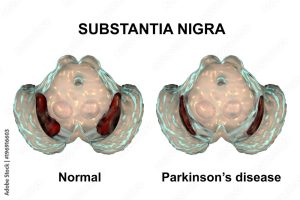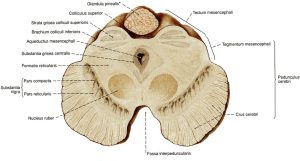
 The pars compacta is a portion of the substantia nigra, located in the midbrain.
The pars compacta is a portion of the substantia nigra, located in the midbrain.
It is formed by dopaminergic neurons and located medial to the pars reticulata.
Parkinson’s disease is characterized by the death of dopaminergic neurons in this region.
The nerve cell bodies of the pars compacta are colored black by the pigment neuromelanin.
The degree of pigmentation increases with age.
This pigmentation is visible as a distinctive black stripe in brain sections.
The neurons have particularly long and thick dendrites that go down deeply in the pars reticulata.
The neurons of the pars compacta receive inhibiting signals from the collateral axons from the neurons of the pars reticulata.
The dopaminergic neurons of the pars compacta project many of their axons along the nigrostriatal pathway to the dorsal striatum, where they release the neurotransmitter dopamine.
Dopaminergic axons also innervate other elements of the basal ganglia system, including the lateral and medial pallidum,substantia nigra pars reticulata, and the subthalamic nucleus.
The function of the dopamine neurons in the substantia nigra pars compacta (SNc) is complex.
SNc neurons do not directly stimulate movement, but have an indirect role by regulating the more direct role of the striatum, contributing to fine motor control.
The lack of pars compacta neurons has a large influence on movement, as evidenced by the symptoms of Parkinson’s disease.
Dopamine neurons are thought to be involved in learning to predict which behaviors will lead to a reward such as food or sex.
It is suggested that dopamine neurons fire when a reward is greater than that previously expected; a key component of reinforcement learning.
Many recreational drugs, such as cocaine, mimic this reward response providing an explanation for their addictive nature.
Degeneration of pigmented neurons in this region is the principal pathology that underlies Parkinson’s disease.
This depigmentation can be visualized in vivo with Neuromelanin MRI.
Parkinsonism can also be produced by viral infections such as encephalitis or a number of toxins.
Many such toxins appear to work by producing reactive oxygen species.
Binding to neuromelanin by means of charge transfer complexes may concentrate radical-generating toxins in the substantia nigra.
Pathological changes to the dopaminergic neurons of the pars compacta are also thought to be involved in schizophrenia and psychomotor retardation sometimes seen in clinical depression.
